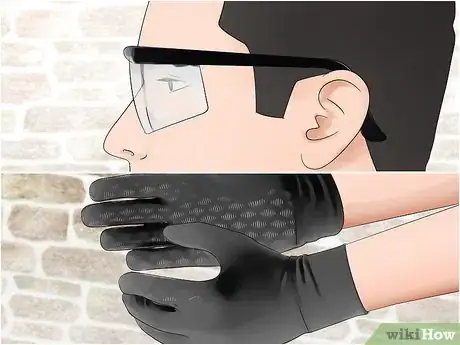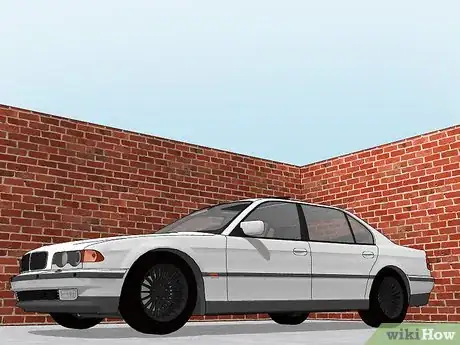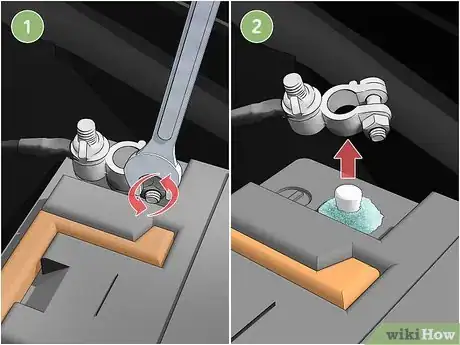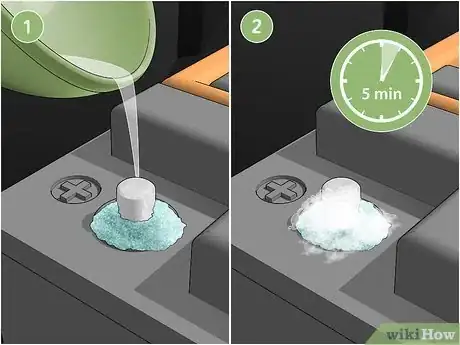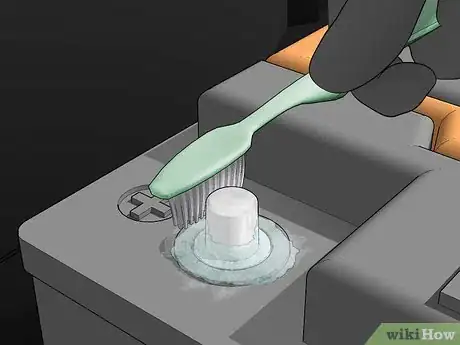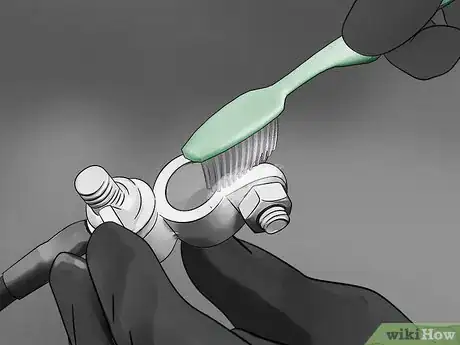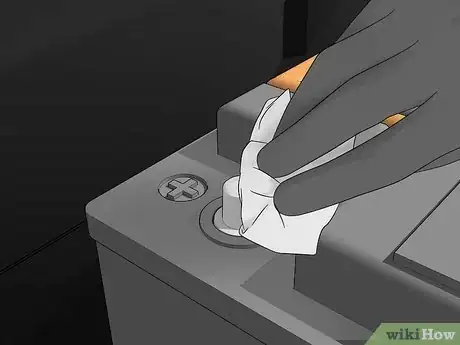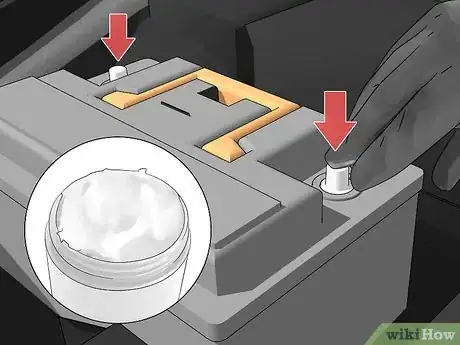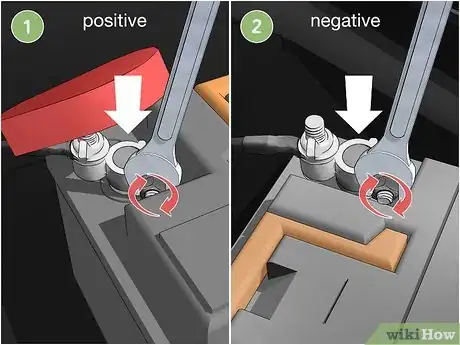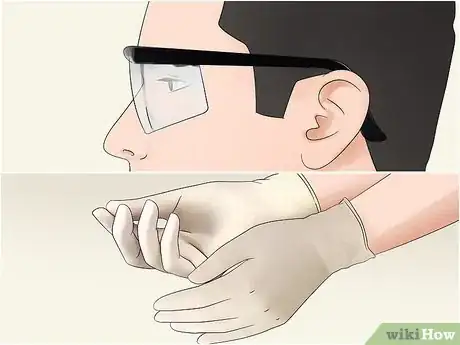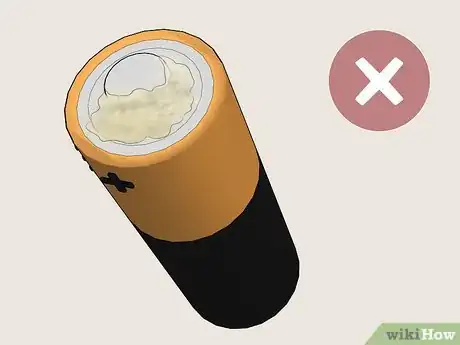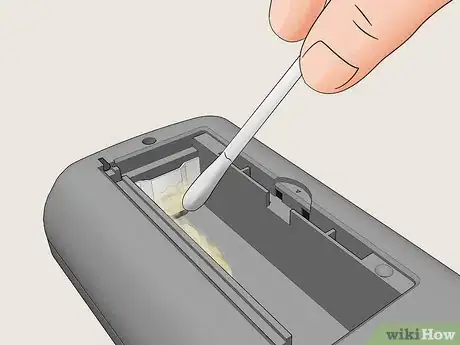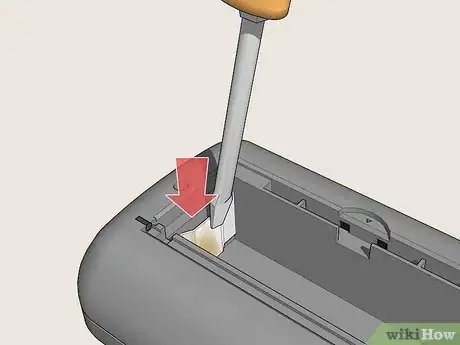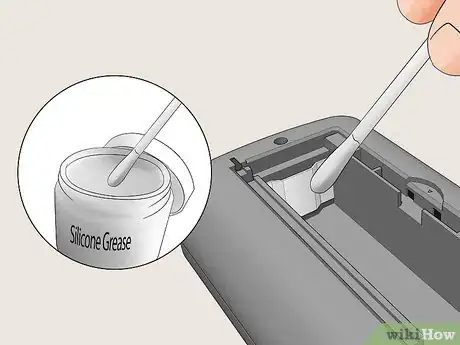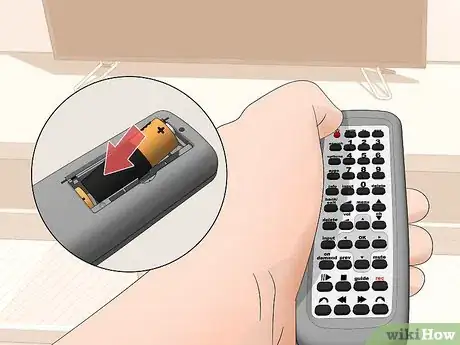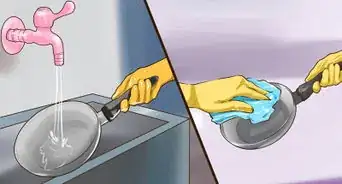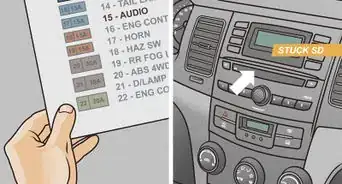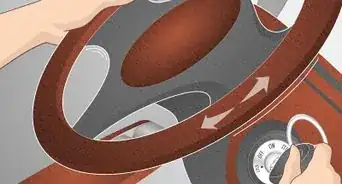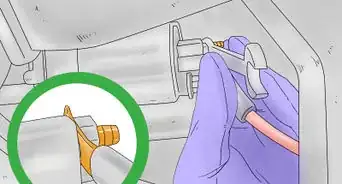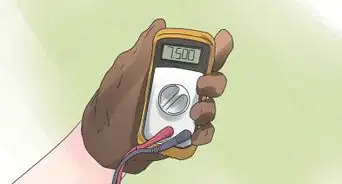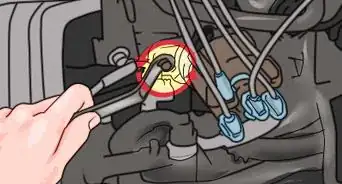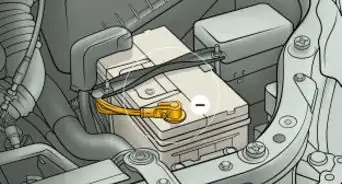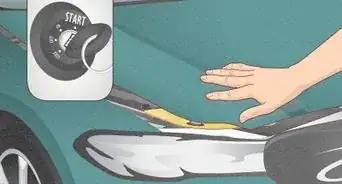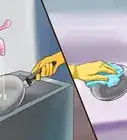This article was co-authored by Duston Maynes and by wikiHow staff writer, Megaera Lorenz, PhD. Duston Maynes is an Automotive Repair Specialist at RepairSmith. Duston specializes in leading a team that handles a variety of automotive repairs including replacing spark plugs, front and rear brake pads, fuel pumps, car batteries, alternators, timing belts, and starter motors. Duston holds an Associate’s degree in Automotive/Diesel Technology from The Universal Technical Institute of Arizona and is a Certified Diagnostic Technician and Automobile Mechanics Technician through BMW STEP. RepairSmith received The 2020 Big Innovation Award by Business Intelligence Group and The Startup of the Year by the American Business Awards. RepairSmith was also included in Built in LA’s 50 Startups to Watch and The Business Intelligence Group’s 52 Names Leading the Way in Customer Service. RepairSmith offers in-home services to provide car owners convenient and complete auto repair everywhere.
There are 17 references cited in this article, which can be found at the bottom of the page.
wikiHow marks an article as reader-approved once it receives enough positive feedback. In this case, 100% of readers who voted found the article helpful, earning it our reader-approved status.
This article has been viewed 1,375,221 times.
When corrosion builds up on a car battery’s posts and terminals, it can cause a variety of electrical problems or even prevent your car from starting altogether. Similarly, when alkaline batteries leak, they can corrode the battery compartment and contacts and prevent your device from working. Fortunately, you can clean up both kinds of battery corrosion easily with a few household supplies and basic tools. Just be sure to protect yourself from the caustic battery fluids by wearing rubber work gloves and safety goggles.
Steps
Disconnecting Your Car Battery Safely
-
1Put on rubber gloves and safety goggles. Car batteries contain corrosive acid, which can irritate your skin and eyes. Before you start, put on a pair of heavy-duty work gloves made of rubber, nitrile, or neoprene.[1] These will also help protect you from possible electric shock. Wear goggles that can protect your eyes from splashes or sparks as you work with the battery and cables.[2]
- It’s also a good idea to wear clothing that covers your skin well, such as a long-sleeved shirt and long pants. Wear old clothes, since you’ll probably get greasy and dirty during the cleaning process.[3]
-
2Park your car in a well-ventilated area. When you work on a car battery, it’s important to do so outside or in a well-ventilated carport. Car batteries release hydrogen gas, which can cause an explosion if it comes into contact with a spark in an enclosed space.[4]
- Never smoke while working on a car battery.
- Make sure the ignition is off, since having your car on can also increase the risk of sparks or explosions.
Advertisement -
3Open the hood of the car to access the battery. Open the driver’s side door of your car and find the hood latch or button. It may be located on or under the dashboard of your car. Pull the latch or press the button to pop the hood. Use the metal bar located inside the engine compartment to prop open your hood.
- Car batteries are typically easy to spot. They are rectangular boxes, often black, and usually with a red cap over one of the terminals. Many of them feature prominent yellow or white warning labels.
- While most car batteries are located under the hood, some models have them in other locations, such as in the trunk or under the back seat. If you can’t find your battery easily, consult the owner’s manual for your car.[5]
- It's a good idea to let your vehicle cool down before you do this—if the engine's been running recently, you could burn yourself if you touch something hot. Also, if the battery is hot, there could be a buildup of gas, and that could potentially cause an explosion.[6]
-
4Disconnect the negative battery terminal. Locate the negative terminal on your battery, which typically has a black cap and a “-” or “NEG” written on it. Lift the plastic cap to expose the terminal. Use a wrench to loosen the nut on the cable clamp and a terminal spreader to open up the cable terminals, if necessary. Terminal spreaders are particularly helpful for overly tightened or stubborn terminal clamps.[7]
- If there’s a lot of corrosive buildup, it might take some effort to work the cable connecter loose after you loosen the bolt. It can be helpful to pry it loose with a flathead screwdriver or prying tool.[8]
- Always disconnect the negative cable, or ground clamp, first. This will prevent a dangerous short circuit.[9]
Warning: To prevent shocks and sparks, never leave your tools sitting on top of the battery.
-
5Unhook the positive battery terminal. Next, move on to the positive terminal, which usually has a red cap and is labeled “+” or “POS.” Lift up the cap and then use your wrench to loosen the positive cable clamp.[10]
- Move the disconnected cable terminals out of the way so they won’t touch the battery posts while you work.
Removing Car Battery Corrosion with Baking Soda
-
1Mix 1 cup (240 mL) of water with 1 teaspoon (4.6 g) of baking soda. Pour the baking soda into lukewarm or cold water and mix them together thoroughly. This mixture will dissolve corrosion on the battery posts and cable terminals and also help neutralize any acid.[11]
- You can also purchase commercial battery cleaners for this purpose. These typically come in the form of a spray-on foam. Look for them in a local auto parts store or in the automotive section of a department store.[12]
- Alternatively, you can clean off the corrosion by pouring a small amount of cola over it!
-
2Pour half of your baking soda solution over the battery posts. When you’ve poured about half the mixture onto the posts, set the rest aside so you can use it to clean the terminals.[13]
- If there’s a lot of corrosive buildup, let the mixture sit for at least 5 minutes before you try to scrub it off.
- Some automotive experts recommend dipping a brush into the baking soda mixture and using that to scrub the battery, rather than pouring the mixture directly onto the battery.[14]
- Alternatively, you can remove the battery before cleaning it. This will allow you to clean up any corrosion that’s gotten onto other parts of the battery or into the battery box.[15] You can also take this opportunity to inspect your battery for signs of damage, such as cracks or bulges in the casing.
-
3Scrub the battery posts with a toothbrush. Take an old toothbrush or a battery post and terminal brush and scrub the posts to clean off the corrosion.[16] If the corrosion is fairly light, the baking soda solution may do most of the work for you, in which case, you won’t need to do much scrubbing.[17]
- You can also use a wire brush to clean off the residue.
-
4Use the rest of the solution to wash the cable terminals. If there’s corrosive buildup on the terminal clamps, pour the remaining baking soda solution over them. Use your toothbrush or a terminal brush to scrub away any residue that remains.[18]
- Focus on the parts of the terminals that make direct contact with the battery posts.[19]
-
5Wipe the posts and terminals dry with a clean rag. Take a clean shop rag and carefully wipe the battery posts and cable terminals to get rid of any remaining moisture or residue.[20] If there’s a lot of debris, you can rinse the terminals and posts first with cool water from a hose or spray bottle.[21]
- Make sure the terminals and posts are completely dry before you attempt to reconnect your battery. You’re not likely to get a severe electric shock from handling a wet car battery, but it’s best to use caution.
-
6Apply petroleum jelly to the posts to prevent corrosion. Before you reconnect the battery terminals, rub a generous amount of petroleum jelly on each post. This will help prevent corrosion from forming on the posts and terminals again.[22]
- You can get petroleum jelly at most drug stores.
-
7Reconnect the battery terminals, positive first. Put the positive terminal back on the positive post and use a wrench to tighten it in place. Next, do the same with the negative terminal. When you’re done, start your ignition to make sure the car will start and run properly.[23]
- Make sure that you’ve removed all tools and cleaning supplies from the area around the battery before you close the hood.
Cleaning Corrosion on Alkaline Battery Contacts
-
1Put on rubber gloves and safety goggles. While the “acid” in alkaline batteries is not actually acidic, it’s still corrosive. Protect your skin and eyes by putting on household gloves (such as nitrile or rubber cleaning gloves) and safety glasses or goggles before you start working.[24]
- It’s also a good idea to protect your workspace by spreading out some newspapers or a plastic tablecloth.
-
2Dispose of the corroded battery. Once an alkaline battery starts to leak, it’s not good anymore. Depending on where you live, you may be able to throw the batteries away in your regular trash, or you may need to take them to a hazardous waste disposal facility. Call your local sanitation department to find out what to do with the batteries.[25]
- If you live in the U.S., you can use the Earth911 Recycling Locator to find facilities near you that will accept alkaline batteries for recycling.[27]
Tip: To prevent the spread of caustic battery fluid, you may wish to use vinegar or lemon juice to clean any corrosion off the batteries themselves before throwing them away.[26]
-
3Dip a cotton swab in white vinegar or lemon juice. Unlike a car battery, alkaline batteries are filled with an alkaline, or basic, fluid. You’ll need a slightly acidic cleaning agent to neutralize the fluid and clean up the corrosion. Pour a little white vinegar or baking soda into a glass or plastic bowl, then dip a cotton swab in it.[28]
- You can also use a small toothbrush.
- Take care not to oversaturate the swab so that you don’t get liquid inside the electrical components of your device. It should be damp but not dripping wet. You can always squeeze the swab to remove any excess.
-
4Wipe the battery compartment and contacts with the swab. Take the cotton swab dipped in vinegar or lemon juice and rub it around inside the battery compartment wherever you see corrosion, especially on the battery contacts. This will start the process of dissolving and neutralizing the corrosion. Wipe the contacts dry with a clean paper towel when you’re done.[29]
- Make sure to get inside the springs.
-
5Scrape away any remaining residue with a metal tool. Use a small blade or flathead screwdriver to scrape off any stubborn corrosion that remains after wiping down the battery contacts. You can also use a fiberglass pen brush.[30]
- Do this lightly so you don’t scratch up the contacts too much!
-
6Coat the contacts with silicone grease to prevent tarnishing. When you’ve scraped away as much of the corrosion as possible, use a cotton swab to apply a light coating of silicone grease to the contacts. You can also use petroleum jelly. This will prevent future tarnishing and improve the connection between the contact and the battery.[31]
- Look for silicone grease in your local hardware store. You can also get petroleum jelly in most drug stores.
-
7Turn your device on to make sure it works. Put fresh batteries into your device and close the compartment, then turn it on. If it doesn’t work, you may need to do more cleanup or replace your device.[32]
- If the battery terminals are too badly corroded to save, you may be able to replace them with new ones. You can buy replacement terminals online or from an electronics store, or scavenge some from another electronic device.
Expert Q&A
-
QuestionDoes baking soda clean battery residue?
 Duston MaynesDuston Maynes is an Automotive Repair Specialist at RepairSmith. Duston specializes in leading a team that handles a variety of automotive repairs including replacing spark plugs, front and rear brake pads, fuel pumps, car batteries, alternators, timing belts, and starter motors. Duston holds an Associate’s degree in Automotive/Diesel Technology from The Universal Technical Institute of Arizona and is a Certified Diagnostic Technician and Automobile Mechanics Technician through BMW STEP. RepairSmith received The 2020 Big Innovation Award by Business Intelligence Group and The Startup of the Year by the American Business Awards. RepairSmith was also included in Built in LA’s 50 Startups to Watch and The Business Intelligence Group’s 52 Names Leading the Way in Customer Service. RepairSmith offers in-home services to provide car owners convenient and complete auto repair everywhere.
Duston MaynesDuston Maynes is an Automotive Repair Specialist at RepairSmith. Duston specializes in leading a team that handles a variety of automotive repairs including replacing spark plugs, front and rear brake pads, fuel pumps, car batteries, alternators, timing belts, and starter motors. Duston holds an Associate’s degree in Automotive/Diesel Technology from The Universal Technical Institute of Arizona and is a Certified Diagnostic Technician and Automobile Mechanics Technician through BMW STEP. RepairSmith received The 2020 Big Innovation Award by Business Intelligence Group and The Startup of the Year by the American Business Awards. RepairSmith was also included in Built in LA’s 50 Startups to Watch and The Business Intelligence Group’s 52 Names Leading the Way in Customer Service. RepairSmith offers in-home services to provide car owners convenient and complete auto repair everywhere.
Automotive Repair Specialist Yes, it does. Lightly brush a mixture of warm water and baking soda on the battery terminals, but don't pour it onto the battery.
Yes, it does. Lightly brush a mixture of warm water and baking soda on the battery terminals, but don't pour it onto the battery. -
QuestionHow do you safely clean battery residue?
 Duston MaynesDuston Maynes is an Automotive Repair Specialist at RepairSmith. Duston specializes in leading a team that handles a variety of automotive repairs including replacing spark plugs, front and rear brake pads, fuel pumps, car batteries, alternators, timing belts, and starter motors. Duston holds an Associate’s degree in Automotive/Diesel Technology from The Universal Technical Institute of Arizona and is a Certified Diagnostic Technician and Automobile Mechanics Technician through BMW STEP. RepairSmith received The 2020 Big Innovation Award by Business Intelligence Group and The Startup of the Year by the American Business Awards. RepairSmith was also included in Built in LA’s 50 Startups to Watch and The Business Intelligence Group’s 52 Names Leading the Way in Customer Service. RepairSmith offers in-home services to provide car owners convenient and complete auto repair everywhere.
Duston MaynesDuston Maynes is an Automotive Repair Specialist at RepairSmith. Duston specializes in leading a team that handles a variety of automotive repairs including replacing spark plugs, front and rear brake pads, fuel pumps, car batteries, alternators, timing belts, and starter motors. Duston holds an Associate’s degree in Automotive/Diesel Technology from The Universal Technical Institute of Arizona and is a Certified Diagnostic Technician and Automobile Mechanics Technician through BMW STEP. RepairSmith received The 2020 Big Innovation Award by Business Intelligence Group and The Startup of the Year by the American Business Awards. RepairSmith was also included in Built in LA’s 50 Startups to Watch and The Business Intelligence Group’s 52 Names Leading the Way in Customer Service. RepairSmith offers in-home services to provide car owners convenient and complete auto repair everywhere.
Automotive Repair Specialist Rubber gloves and safety glasses are must-haves before you start cleaning your battery.
Rubber gloves and safety glasses are must-haves before you start cleaning your battery. -
QuestionHow do I clean battery acid off of my trunk?
 wikiHow Staff EditorThis answer was written by one of our trained team of researchers who validated it for accuracy and comprehensiveness.
wikiHow Staff EditorThis answer was written by one of our trained team of researchers who validated it for accuracy and comprehensiveness.
Staff Answer wikiHow Staff EditorStaff AnswerMove the car to a well-ventilated area and put on some safety gloves to protect your hands. Coat the spill liberally with baking soda or a commercial battery acid neutralizer and let it sit for 30 minutes to an hour. Next, use a carpet cleaner or steam cleaner to clean up the baking soda and neutralized acid. Leave your trunk open so the upholstery can air dry.
wikiHow Staff EditorStaff AnswerMove the car to a well-ventilated area and put on some safety gloves to protect your hands. Coat the spill liberally with baking soda or a commercial battery acid neutralizer and let it sit for 30 minutes to an hour. Next, use a carpet cleaner or steam cleaner to clean up the baking soda and neutralized acid. Leave your trunk open so the upholstery can air dry.
Warning
- The information in this article is intended to provide general answers for frequently asked questions about this topic, and may not be applicable to all vehicles. Please refer to your vehicle’s owner’s manual for details about maintenance intervals and other vehicle specifications. If you are unsure about your ability to perform any repair, we recommend contacting a certified automotive technician to perform the necessary work.
Things You’ll Need
Disconnecting Your Car Battery Safely
- Rubber, nitrile, or neoprene work gloves
- Safety goggles
- Wrench
- Terminal spreader
Removing Car Battery Corrosion with Baking Soda
- 1 cup (240 mL) water
- 1 teaspoon (4.6 g) baking soda
- Toothbrush or battery terminal brush
- Clean, dry rag
- Water hose or spray bottle
- Petroleum jelly
Cleaning Corrosion on Alkaline Battery Contacts
- Safety goggles
- Rubber or nitrile work gloves
- White vinegar or lemon juice
- Glass or plastic bowl
- Cotton swabs
- Small blade or fiberglass pen
- Silicone grease or petroleum jelly
References
- ↑ https://www.ishn.com/articles/90718-what-is-the-best-glove
- ↑ Duston Maynes. Automotive Repair Specialist. Expert Interview. 10 June 2021.
- ↑ http://autotrends.org/2018/07/23/car-battery-corrosion/
- ↑ https://www.tdi.texas.gov/pubs/videoresource/spt5batterysafe.pdf
- ↑ https://www.youcanic.com/article/tools-needed-change-car-battery
- ↑ Duston Maynes. Automotive Repair Specialist. Expert Interview. 10 June 2021.
- ↑ http://autotrends.org/2018/07/23/car-battery-corrosion/
- ↑ https://youtu.be/J74vEOdkq0A?t=93
- ↑ https://www.popularmechanics.com/cars/how-to/a1454/4213127/
- ↑ http://autotrends.org/2018/07/23/car-battery-corrosion/
- ↑ http://autotrends.org/2018/07/23/car-battery-corrosion/
- ↑ https://youtu.be/J74vEOdkq0A?t=276
- ↑ http://autotrends.org/2018/07/23/car-battery-corrosion/
- ↑ Duston Maynes. Automotive Repair Specialist. Expert Interview. 10 June 2021.
- ↑ https://youtu.be/J74vEOdkq0A?t=175
- ↑ Duston Maynes. Automotive Repair Specialist. Expert Interview. 10 June 2021.
- ↑ http://autotrends.org/2018/07/23/car-battery-corrosion/
- ↑ http://autotrends.org/2018/07/23/car-battery-corrosion/
- ↑ https://youtu.be/J74vEOdkq0A?t=254
- ↑ http://autotrends.org/2018/07/23/car-battery-corrosion/
- ↑ https://youtu.be/J74vEOdkq0A?t=343
- ↑ http://autotrends.org/2018/07/23/car-battery-corrosion/
- ↑ http://autotrends.org/2018/07/23/car-battery-corrosion/
- ↑ https://www.bobvila.com/articles/how-to-clean-battery-corrosion/
- ↑ https://www.bobvila.com/articles/how-to-clean-battery-corrosion/
- ↑ https://www.bobvila.com/articles/how-to-clean-battery-corrosion/
- ↑ https://earth911.com/recycling-guide/how-to-recycle-single-use-batteries/#recycling-locator
- ↑ https://www.bobvila.com/articles/how-to-clean-battery-corrosion/
- ↑ https://youtu.be/wJAcqlNHpZs?t=247
- ↑ https://youtu.be/wJAcqlNHpZs?t=121
- ↑ https://youtu.be/wJAcqlNHpZs?t=138
- ↑ https://youtu.be/wJAcqlNHpZs?t=367
About This Article
Before cleaning battery corrosion and build up, put on a pair of rubber gloves so the battery acid cannot get on your skin and burn you. Then, remove the battery from the terminal and use a damp towel to wipe away excessive white buildup. If there are dark spots of corrosion on the shiny terminals, you can use fine-grit sandpaper to gently rub it away. Next, use some vinegar on a towel or Q-tip to remove the remaining white powdery build up. Finally, dry the terminals with a lint-free cloth before putting a battery back in. For tips on how to fix a corroded car battery, read on!
